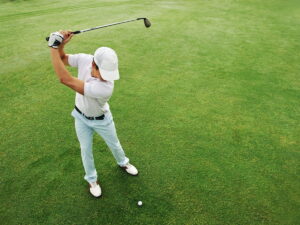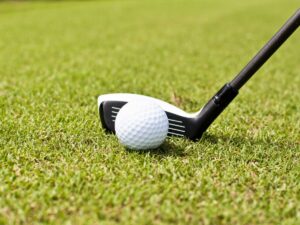
Proper Golf Stance: Top Tips For a Great Golf Setup

- Last Updated on
Contents
Did you know your golf stance plays a huge role in your overall swing?
When it comes to improving your golf game, most people look for the next training aid, golf lesson or quick fix on YouTube is the answer. While others might think that speed training, a new driver, or a different type of putter is the solution.
Because let’s face it, golfers are usually impatient and we’re looking for a solution that can produce results fast. But in reality, playing consistently and shooting lower scores comes down to fundamentals.
While new clubs and gear can help, nothing will help you play more consistent golf than a proper setup position. Specifically, your stance and how it relates to each shot you’re faced with on the golf course. It should change based on the club you’re hitting, total distance, type of lie, and other factors.
The stance is not a “one size fits all” approach. We’ll cover all of that and a lot more today.
Golf Stance Basics
Let’s start by covering the basics from the ground up so you can create an effortless, consistent swing.
Width of Stance
The first thing to think about is the width of your stance. If you’ve played golf for any time I’m sure you’ve realized there is a difference between a wedge vs. driver stance width.
The width of your stance differs based on the club you’re hitting.
Some clubs – like fairway woods and driver – require a wider stance for higher swing speeds to stay balanced. While shorter clubs – like wedges and putters – require a more narrow stance as it’s more about feel than power from close range.
Don’t fall into the trap of thinking your stance is the same for every shot. Instead, alter your stance based on the club and total distance to set yourself up for success.
As Golf Digest pointed out, “As your club gets longer, your ball position moves more forward and your stance gets a touch wider (the widest you’ll ever want to be is just outside shoulder width). As your club gets shorter, your ball position moves farther back (but never back of center) and your stance gets narrower.”
💥 Don’t Miss These Deals 💥

- Pwr-cor technology
- Hot face-highly optimized technology
- Cnc milled infinity face
- Multi-material chassis
- Adjustable weighting

- Increased sole curvature assists with turf interaction
- Multi-material cap back design
- Designed to maximize distance, forgiveness and feel
- Postioned inside the iron head
Three Types of Stances (Square, Closed, or Open)
The second part of your stance is whether it’s square, closed or open to the target.
- Square: This is a neutral position where your feet are parallel to the ball and target (this is known as “parallel left” of the target). Since you’re standing to the side of the golf ball, you don’t want them square to the target itself, but parallel to the left.
- Closed: With a closed stance, your feet point more towards the target or even right of the target. This will help promote an inside to outside swing that should produce more of a draw shot.
- Open: With an open stance, your feet are much further left than “parallel left” of a square stance. This will help promote an outside to inside swing that generally produces a fade.
In a perfect world I’d suggest always using a square stance but as you know, there is no “one way” to swing the club. There are plenty of examples of great players who have used an open stance to become some of the best ball strikers in the world.
Regardless of which type of stance you prefer, something that good players tend to do is flare their feet externally. As Golf.com noted, “Turning your toes out about 20 degrees — maybe even more — effectively makes you more flexible. It creates greater range of motion in your hips, which produces a distance boost in very short order.”
This is even more important with your driver as you want to gain as much distance as possible. Flaring your feet makes it easier to get a bigger turn and thus, more club/ball speed which leads to longer drives. Plus, it helps with irons too – especially if you’re the type of golfer who sometimes sways laterally in your swing.
Add a slight flare to your stance and watch it improve your swing overnight.
Weight Distribution
Another thing to think about during setup is your weight or balance between your feet. Each shot requires you to move your weight differently and it’s important to set up correctly.
For example, with a driver that is teed up, you want to hit up on the golf ball to promote a positive launch angle. But if your weight is 70% on your lead leg, this is nearly impossible and will likely lead to a pop-up. Instead, you want roughly 60% of your weight on your trail leg so that you’re more likely to hit the ball on an upward angle.
Similarly, with wedges, you want your weight more on the lead side to promote a descending blow. If too much weight is on the back leg, you’ll hit the ball with the bottom grooves and thin it.
With irons, you want your weight distributed roughly 50-50 (or 55-45) to promote compression.
Related: Learn How to Shift Your Weight
Knee Flex
Another important part of building a solid stance is the amount of knee flex at address position. You want some knee flex, like an athlete in any other sport but not too much. Otherwise, you’re squatting down which doesn’t allow you to use your lower body properly.
Here’s how Tiger Woods described the “perfect” knee flex in his book, How I Play Golf.
“I want just enough bend in my knees to feel balanced and ready for action. I have a sense of being light on my feet. My weight is distributed evenly from heel to toe, and my hips and shoulders are ready to rotate freely with full cooperation from my legs and feet.”
This helps activate the lower body properly and create ground force to push up and generate more power. Too much knee bend reduces shoulder turn and doesn’t allow you to create enough speed. While too little knee flex minimizes the lower body movement and leads to poor balance.
Distance from the Golf Ball
Do you stand too close to the golf ball, too far away, or just the right amount? This is something that most everyday golfers never consider in their stance and can hurt your swing before it even begins.
As Tiger Woods also said in his book, “Standing the correct distance from the ball at address is vital if I am to make a sound swing. If I’m too close or too far away, I’m forced to make all sorts of anatomical adjustments in order to compensate – and I won’t compensate very well.”
To address the ball properly you want to:
- Bent over at the hips.
- Have your knees flexed.
- Let your arms hang freely.
This will allow you to rotate around your spine and not change the angle throughout the swing. Whether you’re hitting a driver, 5-iron, or wedge, your hands remain the same distance from your thighs.
Ball Position
The final checkpoint in your stance is ball position. This will differ based on the club and shot you’re about to play which I’ll break down in the next section.
Golf Stance For Each Type of Clubs
As mentioned earlier in the Golf.com article, there is no “one size fits all” stance. Instead, it changes based on the club you’re hitting.
Driver and Fairway Wood Stance
To make the right move with your driver, stance and ball position are key to success.
With a driver, you want the ball off the left heel (assuming you’re a right-handed golfer) so that you hit up on it at impact to increase launch angle. Remember, a driver is teed up so you need to adjust the ball position in your stance.
Your driver stance should be slightly wider than shoulder width apart. Doing this will allow for a full body turn and create maximum power in your swing. But don’t overdo it and think wider is bigger – just more than shoulder width is perfect.
For fairway woods off a low tee or the deck, you will need to adjust ball position again. Since it’s not teed up high, you want to actually make a slightly descending blow.
A great example of this is Henrik Stenson who is basically the terminator with a 3-wood (check out the below video). With fairway woods, the ball position is in the front center, but definitely not off your left heel like a driver. A slightly narrower stance than the driver is perfect.
Iron Stance
With irons, you want the ball position in the middle to middle front of your stance.
For longer irons or hybrids, go with a front middle ball position. With shorter irons, play them in the middle of your stance (not back) to hit down on the golf ball.
You also want your feet about shoulder width apart and narrower than a driver or fairway wood.
Wedge Stance
With wedges, your stance is usually much more narrow than with irons or woods. Since most of us only hit wedges under 130 yards or so, you don’t need a wide stance.
Another thing to evaluate with wedges is the ball position itself. You want it more in the middle of your stance (unless you’re trying to hit it high). Adjusting it to the middle will help hit down and through the shot.
Putting Stance
The last type of shot to think about your stance is putting.
Your putting stance is unique, as it’s more about feel and confidence than technique. If you watch the best players in the world, you will notice that every golfer has their own style without a set stance or grip.
For example, some professional golfers use mallet putters and other use blades. Some golfers set up slightly open to the target, while others are more square. Some players take it straight back, while others prefer an arc style.
The point is, putting is extremely individual and recommend finding what works best for you. When mastering your own putting, experiment with:
- Stance.
- Posture.
- Ball position.
- Feet alignment.
- Different types of putters.
Top Questions About Stance and Setup
Do you have more questions about getting into the right stance at address position? Keep scrolling to learn more now so you can have better golf fundamentals fast.
What is a proper golf stance?
A proper golf stance is one of the keys to developing a consistent swing.
A good stance is wide enough but not too wide that makes it easier to sway. It’s also not too narrow so that it doesn’t allow you to build a good base and generate power.
It’s important to remember that your stance changes based on the shot you’re hitting. Longer clubs require a wider stance, while shorter clubs require a more narrow stance. Flaring your feet is also another way to improve your stance and get the maximum amount of rotation as well.
Finally, don’t forget to use alignment sticks to ensure your stance is aligned properly in practice. Too many golfers have the right type of stance but aren’t aimed properly which can hurt your game.
Where should the ball be in your stance when hitting irons?
It depends on the iron you’re hitting; longer irons need to be slightly further up in your stance vs. shorter irons or wedges. This allows you to “bottom out” properly and make solid contact with irons.
With shorter irons and wedges you need to have more of a middle golf ball position for proper contact. Plus, you have the option to change the ball position with irons to change your shot shape.
For example, if you want to hit a fade it’s better to play the shot more toward your front foot. But if you need to hit a draw, you’ll want to move the ball more back in your stance. That’s the beauty of irons – you can adjust them based on your shot shape and trajectory.
How do I align my golf stance?
Alignment is another key component of playing your best golf. If your alignment is off, your swing will suffer as a result.
The best way to align yourself is by checking your aim in practice and on the golf course. In practice, use alignment sticks to ensure you don’t develop any poor aiming habits.
But when you’re on the course, have a friend record your swing sometimes to check your alignment. I’ve noticed that sometimes I take too big of a step as I walk into the ball which leads to a closed stance and aiming right at the target (when I don’t intend to). Recording your swing is a great way to spot bad habits and improve your aim on the golf course.
How do you hit irons pure every time?
Hitting pure irons is a great feeling and one that a lot of amateurs don’t feel enough. Why? Because a lot of players don’t understand that you hit the ball, then the turf for a proper divot.
So many golfers try to “scoop” the ball and it makes it nearly impossible to compress irons and make solid divots. To hit irons more consistently make sure to:
- Improve your grip. Whether you’re hitting drivers, woods, or irons, a solid grip is the foundation to a good swing.
- Master your stance and ball position. As demonstrated in this article, a good stance is one of the most important fundamentals to becoming a more consistent ball striker.
- Play the right irons for your game. If you’re a higher handicap golfer, use more forgiving clubs and graphite shafts. If you’re a lower handicap golfer, use muscle backs or smaller cavity back clubs and heavier shafts.
Finally, try to hit more knockdown or three-quarter shots with irons like the pros do. Too many amateur golfers try to hit every iron with 100% effort and leads to improper sequencing. Instead, hit more controlled and smooth swings so you make better contact more consistently.
Should my hands be in front of the ball at the address?
It depends on the shot and club you’re hitting. Pressing your hands slightly ahead at address position can help you make better contact with irons. This small move makes it easier to keep your hands ahead of the ball for more compression at impact.
However, you don’t want your hands ahead on all shots.
For example, you don’t need to forward press with a driver as you’ll de-loft the club and make it harder to launch it correctly. It’s best to play your driver with your hands equal to the ball or even slightly behind.
Your putter is another club that can benefit from a forward press motion. Some of the best putters ever use a slight forward press to initiate the backstroke and hit the putt correctly. Try out a forward press on the putting green to see how it might help your putting too.
Wrapping Up
As you can tell, there are a lot of components to getting the right stance and setup at address. But when you master this part of the swing, everything becomes easier as you set yourself up for success.
For a quick recap, make sure to:
- Have an athletic stance with knees bent and your feet flared out.
- Remember the three types of stances to match your ideal shot shape.
- Adjust your weight and ball position to execute the shot and trajectory.
- Alter your stance width based on the club you’re hitting (longer the club, wider the stance).
Don’t forget, your stance will change based on the shot you’re hitting. Your driver setup vs. a short wedge is very different, so make sure to adjust accordingly.
Once you’re set up properly, commit to the shot and swing away.
Do you feel confident about your stance at address position? Or, is this something you’re constantly working on?
Let us know down below in the comments.

Michael Leonard
Michael Leonard is a full-time writer, author, creator of Wicked Smart Golf and +1 handicap amateur golfer. He left his corporate career in 2017 to pursue entrepreneurship and professional golf; since then, he’s competed in 160+ tournament days and went to Q-school in 2019.






